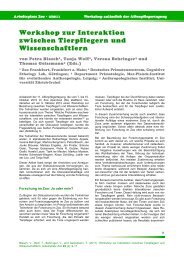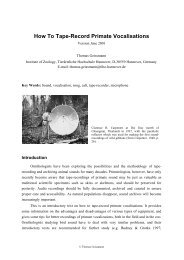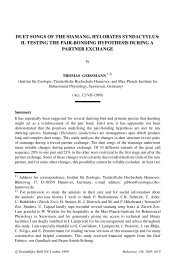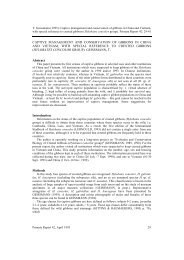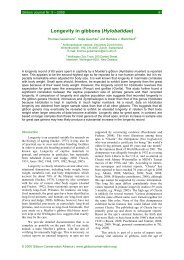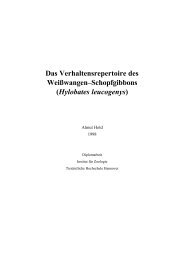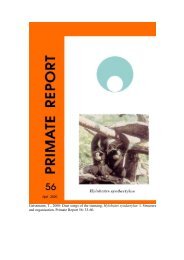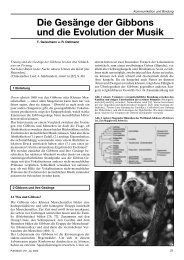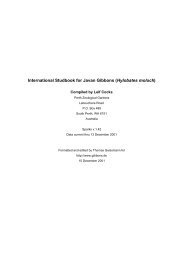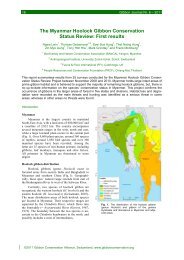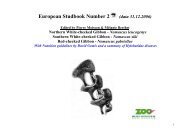The male song of the Javan silvery gibbon (Hylobates moloch)
The male song of the Javan silvery gibbon (Hylobates moloch)
The male song of the Javan silvery gibbon (Hylobates moloch)
- No tags were found...
You also want an ePaper? Increase the reach of your titles
YUMPU automatically turns print PDFs into web optimized ePapers that Google loves.
12 T. Geissmann et al. – <strong>The</strong> Male Song <strong>of</strong> <strong>the</strong> <strong>Javan</strong> Silvery GibbonNote TypeAProgress <strong>of</strong> <strong>song</strong> bout (time)10Howletts 1Howletts 2Munich (Mean)B1, B28B3, B4, C, E6Build-upphaseMain phaseFig. 4. Diagram <strong>of</strong> <strong>the</strong> changes in <strong>the</strong> note repertoire usedduring various phases <strong>of</strong> <strong>the</strong> <strong>song</strong> bout <strong>of</strong> <strong>male</strong> <strong>silvery</strong> <strong>gibbon</strong>s.Inter-phrase interval<strong>The</strong> <strong>male</strong> <strong>song</strong>s <strong>of</strong> H. <strong>moloch</strong> appear to be highlyvariable. We found virtually no stereotypic repeatedstructures comparable to <strong>the</strong> so-called great callphrases <strong>of</strong> <strong>the</strong> fe<strong>male</strong> <strong>song</strong>s (Dallmann and Geissmann,2001a, b). This impedes <strong>the</strong> recognition <strong>of</strong>phrases (i.e. <strong>of</strong> elements which are typically utteredin recognisable sequences). Because <strong>the</strong> note intervalswithin phrases are, by definition, shorter thanthose between phrases, it should be possible toidentify a critical interval duration which discriminatesparticularly well between inter-phrase andintra-phrase intervals. For this purpose, we determined<strong>the</strong> frequency distribution <strong>of</strong> note intervaldurations in steps <strong>of</strong> 0.02 s for <strong>the</strong> <strong>song</strong>s <strong>of</strong> each<strong>male</strong>. We expected that both inter-phrase intervalsand intra-phrase intervals would both occur morefrequently than intermediate note intervals. <strong>The</strong>latter should be recognisable as a trough in <strong>the</strong> frequencydistribution curve and represent a suitablecritical interval duration distinguishing betweeninter-phrase intervals and intra-phrase intervals.Each <strong>song</strong> appears to exhibit several localminima in <strong>the</strong> frequency distribution <strong>of</strong> <strong>the</strong> noteintervals. Most minima occur in some individualsonly, but not in o<strong>the</strong>rs. A through near 0.75 s consistentlyoccurred in <strong>the</strong> frequency distribution <strong>of</strong>all study animals, however. <strong>The</strong>refore, we defined0.75 s as <strong>the</strong> critical interval. In <strong>the</strong> following analysis,notes separated by an interval <strong>of</strong> more than0.75 s are considered as belonging to differentphrases. Likewise, non-phrase notes (i.e. singlenotes) must be isolated from all o<strong>the</strong>r notes byintervals <strong>of</strong> more than 0.75 s.Song motivationSong motivation (i.e. <strong>the</strong> <strong>gibbon</strong>’s drive to sing)cannot be measured directly. As an estimate forMean number <strong>of</strong> notes per phrase4201086420Jakarta 1 (Mean)Jakarta 2HalimunKalejetan0 200 400 600 800 1000 1200 1400 1600Rank <strong>of</strong> note in <strong>song</strong> boutFig. 5. Song motivation (number <strong>of</strong> notes per phrase) inconsecutive 50-note sections <strong>of</strong> <strong>the</strong> <strong>male</strong> <strong>song</strong> bouts <strong>of</strong><strong>Hylobates</strong> <strong>moloch</strong>. <strong>The</strong> Halimun, Jakarta 1, Jakarta 2 andKalejetan <strong>male</strong>s are plotted separately, because <strong>the</strong> beginnings<strong>of</strong> <strong>the</strong>ir <strong>song</strong> bouts were not recorded on tape.<strong>song</strong> motivation, we use <strong>the</strong> average number <strong>of</strong>notes per phrase, determined over consecutive <strong>song</strong>sections <strong>of</strong> 50 notes. Inspiration notes were ignoredin this calculation.In Figure 5, <strong>song</strong> motivation is shown as afunction <strong>of</strong> <strong>song</strong> bout progression, as determined ingroups <strong>of</strong> 50 consecutive notes. At <strong>the</strong> beginning <strong>of</strong>a <strong>song</strong> bout, <strong>the</strong> average number <strong>of</strong> notes per phraseis below a value <strong>of</strong> 1.7 notes (Figure 5, uppergraph). In each case, <strong>song</strong> motivation increasesearly during <strong>the</strong> <strong>song</strong> bout (i.e. during about <strong>the</strong>first 200 - 250 notes). During <strong>the</strong> main part <strong>of</strong> <strong>the</strong><strong>song</strong> bout, <strong>song</strong> motivation may still exhibit considerablefluctuations, but tends to remain within arange <strong>of</strong> 2.5 - 4.0 notes/phrase.<strong>The</strong> beginning <strong>of</strong> <strong>the</strong> <strong>song</strong> bouts from Halimun,Jakarta 1, Jakarta 2 and Kalejetan (Figure 5, lowergraph) was not recorded on tape. An initial increasein <strong>song</strong> motivation is not visible in <strong>the</strong>se <strong>song</strong>bouts. <strong>The</strong> <strong>song</strong>s <strong>of</strong> <strong>the</strong> Jakarta 1 and 2 <strong>male</strong>sexhibit a range <strong>of</strong> <strong>song</strong> motivation resembling <strong>the</strong>



